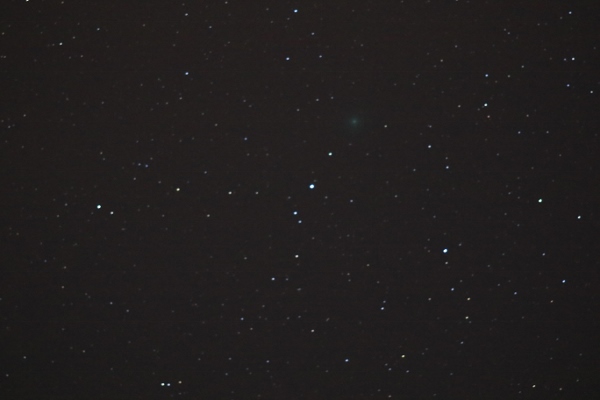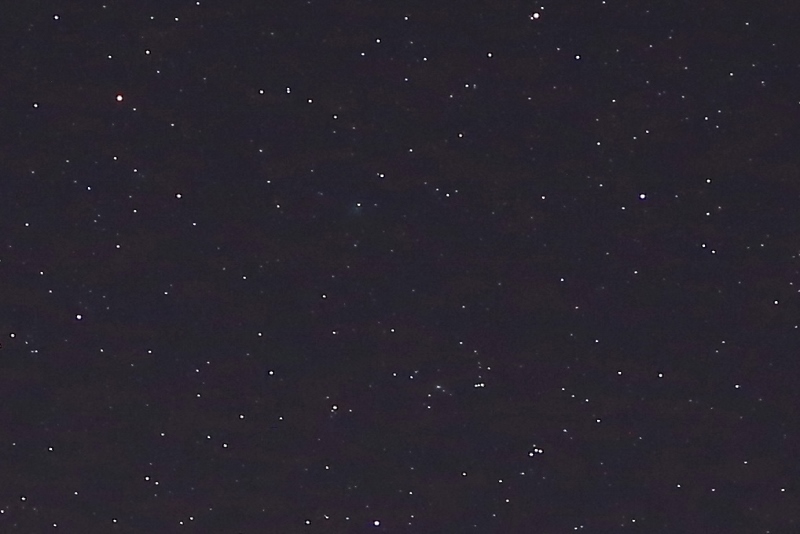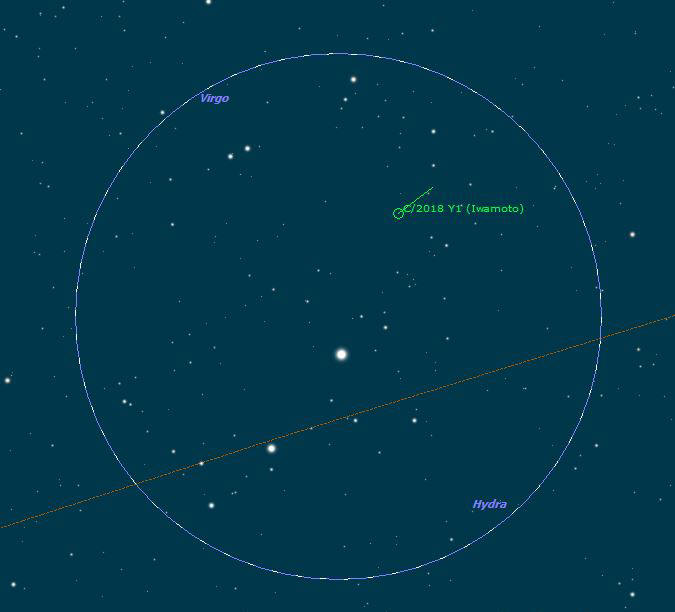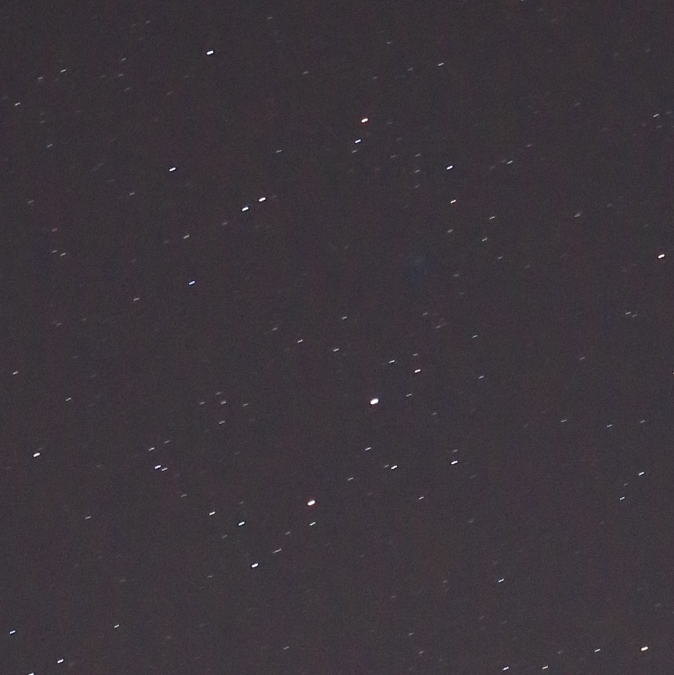
Comet C/2018 Y1 (Iwamoto)
Joe Stieber's Observations and Snapshots
See Bob King's online Sky & Telescope article, Comet Iwamoto Ascends and Brightens, for more information about observing Iwamoto, including a finder chart. It will reach perihelion on Feb 6 and make its closest approach to earth on Feb 12.
February 25, 2019, 10:30 pm EST
Comet C/2018 Y1 (Iwamoto) was observed with a 12.5-inch reflector around 10:30 pm EST from Carranza Field in Wharton State Forest, NJ. It was just a dim patch of haze, so it doesn't look like it will be a prime target during the 2019 Messier Marathon on the prime night of March 9/10. Here's an observing report including the baseball field session as well a session at Carranza Field later that night.
February 24, 2019, 10:30 pm EST
Comet C/2018 Y1 (Iwamoto) was spotted with 15x56 binoculars at 10:30 pm EST from Carranza Field in Wharton State Forest, NJ. It was a dim patch of haze at the threshold of visibility, about three-eighths of the 5° span from Theta Aurigae to the open cluster M37. The coma diameter was a bit less than the 10.5 arc minute span between the outer two stars of a nearby arc of three eighth-magnitude stars (therefore, 7 or 8 arc minutes diameter?). I did not set up the 12.5-inch reflector as there were many passing broken clouds and considerable wind, which made it uncomfortable despite a relatively mild temperature of 45°F.
February 9-10, 2019, 11:00 pm to 1:15 am EST
Before leaving to observe Comet C/2018 Y1 (Iwamoto) at Carranza Field in Wharton State Forest, NJ, I looked from my suburban front yard in Maple Shade, NJ. Around 11 pm EST, I could not see a hint of Iwamoto with 16x70 binoculars. I then stopped at Swede Run in Moorestown, NJ (a less dense suburban site), and I could just see Iwamoto at 11:20 pm with 15x56 binoculars, but it was not as difficult as it was on the morning of February 5 at Swede Run. Initially, the coma was overlapping a magnitude 7.2 star, HD 95848, which probably washed out the coma a bit. However, by my last look before leaving Swede Run about 11:30 pm, the coma had moved off the star and was easier to see.
I arrived at Carranza about 12:15 am on February 10 and as soon as I could get out my 15x56 binoculars, I easily spotted Iwamoto (it was downright obvious in the binoculars, but not seen with unaided eyes). It had moved even farther from HD 95848 (≈westward, or "up" as viewed at the time) and by time I left around 1:15 am, the comet had moved a total of about half a degree from when I first saw it at Swede Run. So, the apparent rate of movement was about 6°/day (SkySafari and SkyTools both show a rate of 6.5°/day at the time). I did not see any color or a tail visually, while the snapshot shows a little greenish color, but still no tail. Competent comet imagers have been capturing a rich greenish color and a tail.

Comet C/2018 Y1 (Iwamoto)
near Chi Leonis. February 10, 2019, 12:40 am EST. Canon 7D Mk
II digital SLR camera + Canon 200 mm f/2.8L lens, fixed tripod.
Exposed 4 seconds at f/2.8, ISO 6400, 4400 K white balance.
Around 1 am, I looked again for comet 46P/Wirtanen in Ursa Major, and took some snapshots, but I did not see a hint of it. It's been almost a month since I last saw 46P (January 15 at Carranza with my 85 mm spotting scope).
February 5, 2019, 3:30 am EST
Comet C/2018 Y1 (Iwamoto) was observed visually from the suburbs on February 5, 2019. Just before 3 am EST, it was not visible from my home in Maple Shade, NJ (about 8 miles east of Philadelphia City Hall) with 15x56 or 16x70 binoculars. Then I went to Swede Run in Moorestown, NJ (5 miles farther east of home), and between 3:15 and 3:45 am EST, I was able to see a very faint fuzzy spot (the comet) half a degree south of the magnitude 7.2 star, HD 107830, which in turn is about 5.5° south of Zaniah (Eta Virginis). I also saw the vague fuzzy spot with my 80 mm, f/6 apo refractor, using several eyepieces. By a slim margin, the 18 mm, 82° Explore Scientific was the best (27x, 3.0 TFOV), but not really better than the binocular views. The sky was decidedly hazy, so transparency wasn't ideal.
February 3, 2019, 4:42 am EST

This image of C/2018 Y1 (Iwamoto) was taken at 4:42 am EST on February 3, 2019, from East Point, NJ, with a Canon 6D digital SLR camera (on a fixed tripod) and a Sigma 50 mm f/1.4 Art lens. This is the same original image that's on my home page, but cropped to 19% of the original linear dimensions for a field 7.6° wide x 5.1° high. Mouseover for labels.
January 30, 2019, 05:00 EST
Screen capture of C/2018 Y1 (Iwamoto) from SkyTools. The comet is about 5° southwest of Spica (Alpha Virginis). The dashed circle represents the field of my 85 mm spotting scope at 60x, 2.2°. The Sky Tools position is about 15 arc minutes west (or 3 hr 15 min ahead) of the position shown by SkySafari, which corresponds with the green comet marker circle on the left. The labeled comet circle is Iwamoto at 5:00 am EST, the left circle is 1:45 am and the right circle is 8:15 am in SkyTools. I first noticed the error by comparison of an image of Iwamoto by Martin Mobberley, taken Jan 29, 14:45 UT, at Siding Spring, Australia. It matched the Sky Safari position, but not SkyTools.
After downloading the elements from the MPC again on the morning of February 11, 2019 (perhaps the fourth time I've done so since noticing the problem with SkyTools), it now plots the correct position.
The image below of C/2018 Y1 (Iwamoto) is a further crop of the image on my main page, taken at 4:54 am EST on January 30, 2019, and covers roughly the same area as the SkyTools clip above (the image is 2.6° wide x 3.4° high). Indeed, the position of the comet closely matches the comet marker on the left (for 1:45 am) rather than the center marker for 5 am in the SkyTools screen capture. This confirms the suspected error in the SkyTools position. However, this positional difference is not as important as it was now that Iwamoto is visible in binoculars. It was seen on January 30 without difficulty using 16x70 binoculars, as well as in an 85 mm spotting scope at 27x to 60x. Mouseover for labels.
January 15, 2019, 05:00 EST

Screen capture of C/2018 Y1 (Iwamoto) from SkyTools. The comet is 4.7° north of Pi Hydrae. The dashed line represents the boundary between Virgo and Hydra. The dashed circle represents the field of a 30 mm 82° eyepiece in a 12.5-inch, f/5 reflector (= 53x, 1.55° TFOV).
Unlike the morning of January 12, Iwamoto was not seen visually on January 15 (using an 85 mm spotting scope at 60x both times), but it was visible on a snapshot taken January 15 (see below). The sky did not seem as dark as I had expected/hoped, probably due to light reflecting off the relatively fresh layer of snow on the field (perhaps an inch or two).
The image below was captured on January 15 at 4:34 am EST with a Canon 6D and a Canon 200 mm f/2.8L lens, exposed 4 seconds at f/2.8, ISO 6400, 4000 K white balance (it's a significant crop from the same image on my home page). It covers roughly the same area as the SkyTools finder chart above in a field about 1.9° square. Mouseover for labels.

January 12, 2019, 05:00 EST
Screen capture of C/2018 Y1 (Iwamoto) from SkyTools. The comet is 4°
north of Pi Hydrae. The dashed line represents the boundary between
Virgo and Hydra. The dashed circle
represents the field of a 30 mm 82° eyepiece in a 12.5-inch, f/5 reflector (= 53x, 1.55° TFOV).
C/2018 Y1 (Iwamoto) was spotted for the first time by me, Joe Stieber, on 12-Jan-2019 at 4:45 am EDT from Carranza Field
in Wharton State Forest, NJ, with an 85 mm spotting scope, best seen at
the maximum 60x. It was at the threshold of visibility and was not seen
with 15x56 binoculars.